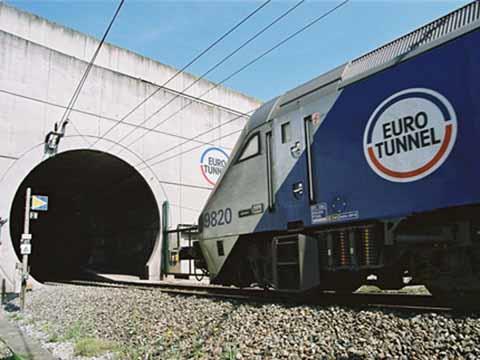
EUROPE: Three months after the devastating fire on September 11 that burned out every lorry on a shuttle train in the Channel Tunnel, we were able to inspect on December 10 the full extent of the damage to 610 m of the concrete lining as repairs continue around the clock.
Having secured the weakened lining segments against movement by grouting in 1 078 bolts 3 m long, water jets at 350 km/h nozzle velocity blasted off the fractured concrete. After replacing the steel reinforcing where necessary, a layer of new concrete about 150 mm thick is now being sprayed on by hand.
Eurotunnel’s Chairman & Chief Executive Jacques Gounon was ‘confident that we will finish by mid-February’ and re-open the 17 km of single-track bore between the crossover cavern and the French portal to normal traffic. But he is also seeking changes in safety rules and procedures that kick-in when a fire is reported, not just on HGV shuttles but on any train in the Tunnel. ‘We have to follow rules applied by the Inter-Governmental Commission’, he stressed, ‘and review jointly proposals to improve the safety of HGV shuttles’.
Gounon’s first aim is to persuade the IGC that as soon as truck drivers riding in the club car at the front of the train are safely evacuated into the central Service Tunnel, the powerful Supplementary Ventilation fans used to blow smoke towards the rear of the train to aid their escape can be shut down. The fact that the IGC required them to be kept running at full speed in both the 1996 and 2008 fires fed the flames and ensured that all vehicles to the rear of the first lorry to catch fire were destroyed.
As in 1996-97, there have been calls for HGV shuttle wagons to be enclosed, but this demands end doors on the wagons for which there is no space within the loading gauge. Indeed, some second generation HGV shuttles wagons built by Arbel in 1999 do not even have full length roofs, and Eurotunnel published in 2008 a third design ‘without a superstructure like those used by other piggyback networks in Europe’.
The other concept Gounon wants the IGC to abandon is splitting Eurostars in the middle in the event of one half catching fire, walking all the passengers in that half into the other half and then driving it out. Little more than a moment’s thought is needed to realise this would be totally impractical with a full 18-car train, and Gounon insists evacuation into the Service Tunnel is the right policy.
He points out that in 14 years no Eurostar has ever been split in this way, and it didn’t happen even when Eurostars failed in the Tunnel on November 28 and 30, although both were stationary for up to 5 h.
The prize here is getting the IGC to allow other modern trains, such as double-deck TGVs or German ICEs built to the continental loading gauge, through the Tunnel to London, potentially increasing capacity at little cost. With Europe’s railways being opened up to competition for international passenger trains from January 1 2010, Gounon sees an extension of open access as an important business opportunity.

















